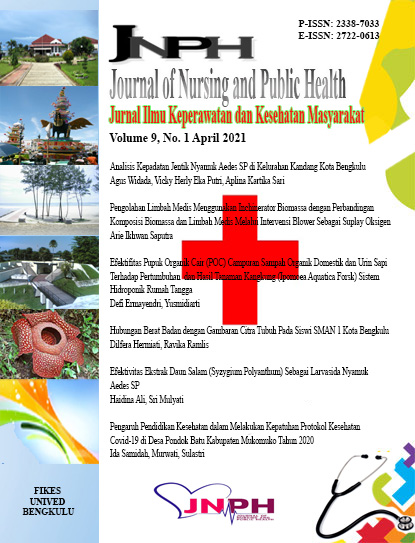EFEKTIVITAS EKSTRAK DAUN SALAM (SYZYGIUM POLYANTHUM) SEBAGAI LARVASIDA NYAMUK AEDES SP
Abstract
Demam Berdarah Dengue (DBD) adalah penyakit yang disebabkan oleh virus Dengue yang tergolong Arthropod-Borne virus genus Flavivirus, dan famili Flaviviridae. Daun salam (Syzygium polyanthum). Tujuan dalam penelitian ini adalah diketahui konsentrasi efektif daun salam (Syzygium polyanthum) sebagai larvasia nyamuk aedes sp. Metode Penelitian ini merupakan rancangan penelitian eksperimen sungguhan (True Experiment) dengan rancangan posttes dengan kelompok control (“ Posttes Only Control Group Design") dengan dianalisis secara deskriptif dan analitik. pengumpulan data secara langsung yang diperoleh dari jumlah kematian nyamuk dan observasi selama penelitian. Penelitian ini didapatkan hasil bahwa konsentrasi 2%, 3%, 4%, 5% paling efektif dalam membunuh larva nyamuk Aedes sp pada konsentrasi 5% mampu membunuh 89,6% larva nyamuk Aedes sp. Diharapkan masyarakat untuk menggunakan insektisida alami seperti ektrak daun salam (Syzygium polyanthum) dalam mematikan larva nyamuk Aedes sp sebagai pengganti insektisida kimiawi.
Downloads
References
Ameliana, 2012. “Jurnal Penerimaan Masyarakat Terhadap Larvasida Alami.” Diakses melaluihttp://journal.unnes.ac.id/nju/ index.php/kemas pada tanggal 24 Desember 2019.
Aradilla, A.S. 2009. Uji Efektivitas Larvasida Ekstrak Ethanol Daun Mimba (Azadirachta indica) terhadap Larva Aedes aegypti. Skripsi. FK UNDIP. Semarang.
Argi Septianto. 2014. Hubungan Antara Praktik Pemberantasan Sarang Nyamuk (PSN) Dengan Keberadaan Jentik Nyamuk Aedes aegypti Di Rw 7 Kelurahan Sukorejo Kecamatan Gunungpati Kota Semarang. Skripsi. Jurusan Ilmu Kesehatan Masyarakat.Universitas Negeri Semarang.
Departemen Kesehatan RI, 2005,Direktorat Jendral Pengendalian Penyakit dan Penyehatan Lingkungan, Bengkulu :DIT . JEN . PP dan PL.
Dinas Kesehatan Kota Bengkulu. (2019). Profil Kesehatan Kota Bengkulu. Bengkulu: Dinas Kesehatan Kota Bengkulu.
Dinas Kesehatan Kota Bengkulu. (2019). Profil Kesehatan Kota Bengkulu. Bengkulu: Dinas Kesehatan Kota Bengkulu.
Dinas Kesehatan Provinsi Bengkulu. (2019). Profil Kesehatan Provinsi Bengkulu. Bengkulu: Dinas Kesehatan Provinsi Bengkulu.
Emi Liana 2017. “ Pengaruh Konsentrasi Ekstra Daun Jeruk (Citrus aurantifolia)Terhadap Mortalitas Larva Nyamuk Aedes Aegypti.
Gafur, A.2006 Perbedaan Jenis Kelamin Aedes Aegypti Berdasarkan Morfologi Sayap, Bioscientiae. 3(1) : 39-49
Ginanjar, G. 2008, Demam Berdarah Yogyakarta: Benteng Pustaka
Hamzah, M.2004. Bionomik Aedes aegypti Jurnal Kedokteran Kesehatan.
Ishardiati, K. 2011. Resistensi Serangga terhadap DDT. Fakultas Kedokteran Universitas Wijaya Kusuma Surabaya.
Isroi, 2009. Isolasi dan Uji Bioessay Bakteri Kotoran Cicak Yang Berpotensi Sebagai Pengendalian Larva Aedes Sp. Prosiding Seminar Nasional dan Internasional.
Istiqomah,2013.Perbandingan Metode Ekstrasi Maserasi dan Sokltasi terhadap kadar Piperin Buah Cabeh Jawa (PiperisRetrofractiFructus).Skripai.UIN Jakarta.
Kementerian Kesehatan RI. (2017). Profil Kesehatan Indonesia 2013. Jakarta: Kementerian Kesehatan RI.
Kementerian Kesehatan RI. (2019). Profil Kesehatan Indonesia. Jakarta: Kementerian Kesehatan RI.
Notoatmojo, S. (2010). Metodelogi Penelitian Kesehatan Jakarta : Rineka Cipta
Prasetyo,2013. Pengololaan Budidaya Tanaman Obat-Obatan (Bahan Simplisia). Bengkulu : Badan Penerbitan Fakultas Pertanian UNIB
Rion Dediq,dkk. (2017). “Daya Bunuh Ekstrak Air Daun Salam (Syzygium Polyanthum) Terhadap Larava Aedes aegypti.
SoegharjoCj.2013 Farmahognos Citra Aji Pramana. Yogyakarta hal 10-11
Sucipto, Cecep Dani. (2011). Vektor Penyakit Tropis, Gosyen Publishing. Yogyakarta
Supranto, J. 2000. Teknik Sampling untuk Survei dan Eksperimen. Penerbit PT Rineka Cipta, Jakarta.
Susanto,dkk. (2018). Hubungan faktor Lingkungan Institusi Pendidikan dan Perilaku Siswa dengan Kejadian Demam Berdarah Dengue Anak Usia 5-14 Tahun. Jurnal Kedokteran Diponegoro. Universitas Diponegoro.
WHO, (2019). WHO Region of the America record highest number of dengue cases in history : case spike in other regions (online), available at:http://www.who.int/news-room/detail/21-11-2019-who-region-of-the-americas-records-highest-number-of-dengue-caes-in-history-case-spike-in-other-regions diunduh 15 januari 2020.
World Health Organization. 2005. Guidelines For Laboratory And Field Testing Of Mosquito Larvacides.World Health Organization Communicable Disease Control, Prevention, And Eradication WHO Pesticide Evaluation Scheme. Geneva : WHO press.

An author who publishes in the Journal of Nursing and Public Health agrees to the following terms:
Author retains the copyright and grants the journal the right of first publication of the work simultaneously licensed under the Creative Commons Attribution-ShareAlike 4.0 License that allows others to share the work with an acknowledgement of the work's authorship and initial publication in this journal
Submission of a manuscript implies that the submitted work has not been published before (except as part of a thesis or report, or abstract); that it is not under consideration for publication elsewhere; that its publication has been approved by all co-authors. If and when the manuscript is accepted for publication, the author(s) still hold the copyright and retain publishing rights without restrictions. For the new invention, authors are suggested to manage its patent before published. The license type is CC-BY-SA 4.0.
Journal of Nursing and Public Health is licensed under a Creative Commons Attribution-ShareAlike 4.0 International License.
You are free to:
Share — copy and redistribute the material in any medium or format
Adapt — remix, transform, and build upon the material
for any purpose, even commercially.
The licensor cannot revoke these freedoms as long as you follow the license terms.









